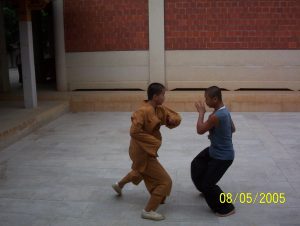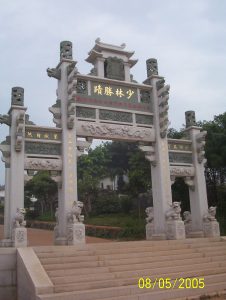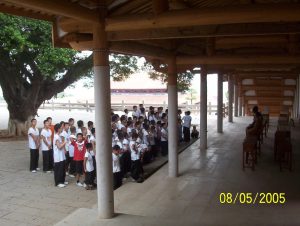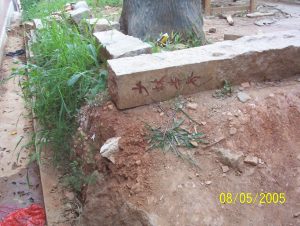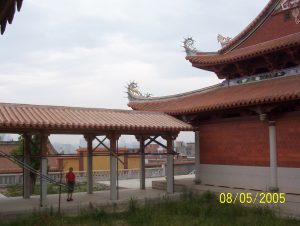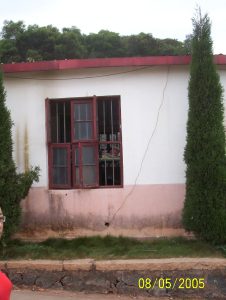
Introduction, from the book: The Riddle of Southern Shaolin (Translated from Shaolin Fang Gu, by Wen Yu Chen ISBN:7-5306-2830-5)
“On July 9, 1992 the ‘Fujian Daily’ran a Zhong Xin wire story entitled ‘Important discovery about Southern Shaolin Temple found in Fujian’s Quan Zhou. The article said, ‘Quan Zhou historical scholars had recently discovered a Qing dynasty record book entitled ‘Records of the Western Mountain.’Within this record the location of the Southern Shaolin Temple was revealed as being just north of Quan Zhou in the Qing Yuan mountains.
The story also reported, ‘Well-known Quan Zhou historian Chen Si Dong introduced the find to this reporter saying that the recently reopened ‘Eastern Zen Shaolin Temple is built on the remains of the Southern Shaolin Temple mentioned in the ‘Records. ‘The ‘Records? were written during the Qing dynasty’s Jia He and Dao Guang emperor’s reigns. Furthermore, the book shows that during the Tang Dynasty’s Zhen Yuan emperor’s reign, Quan Zhou’s scholar Xu Ji’s ‘Records of Central Min’ (Min = present day Fujian, Taiwan and northern Guangdong) have references to ‘Qing Yuan Shaolin Temple.’

Mr. Chen Si Dong later had 13 articles in the Quan Zhou Evening News covering ‘Southern Shaolin Temple at Quan Zhou.’ His resources included the Song Dynasty work ‘Jiading WenLing Records’ edited by Minister Cheng Zhuo, a Ming Dynasty copy of the ‘History of the Qing Yuan area’s an 1810 copy of the Records of the Western Mountain, the 1927 ‘Martial Lineage of the Fu,’and the 1941 ‘Shaolin Martial Arts Reference’by Tang Hao.
Here are the main points Mr. Chen covers. First, all the materials, old to new, record the location of the Southern Shaolin Temple as Quan Zhou’s eastern area, in the Qing Yuan mountain’s eastern peak. The Records of the Western Mountain, say ‘The wisdom of the 13 Empties’ entered Min, built the Shaolin Temple on Qing Yuan Mountain, and settled there. Min’s martial monks all begin from this place. ‘The Shaolin Temple began with 13, and a high wall. The temple’s monks number in the thousands, with hundreds of acres and fragrant forests.’
Because Quanzhou Shaolin opposed the Min ruler, Wang Shen Zhi, the temple was razed for the first time. In the Song dynasty because ‘thousands of monks opposed the Mongols’, the temple was razed for a second time. Then in
1763, the Qing emperor issued orders to raze it again, and it wasn’t rebuilt. Nevertheless, from Mr. Chen’s articles, it is clear that his most relied upon resource is the Record of the Western Mountain. Current understanding is that the ‘Record’ was originally 12 volumes, but more than half were lost in times of war. Still, descendants of Cai Chun Cao saved six volumes. Then, during the cultural revolution, two more volumes were lost. In 1990, Hua Qiao University’s Lin Shao Zhou, while doing research in Jinjiang made several important discoveries, but which are currently unpublished.
The Record that Mr. Chen relies on is an essay of about 1800 characters and has been found to be full of mistakes. Therefore, it can only be taken as fictional.
For example, the ‘Record? reports that the abbot of Shaolin during the end of the Sui dynasty was ‘Qi Xuan’. However, Shaolin’s records report no such person. The ‘Record? also reports that the ‘13 Staff Monks’ were named ‘First Empty, Half Empty, Non Empty, Emptiness of Color, Zen Empty, Understanding Empty, Enlightened Empty, Empty Wisdom, Quiet Empty, Really Empty, Truly Empty, Empty Law and Empty Rule.
However, this is impossible. In the Sui and Tang times, there are no examples of this sort of naming convention for groups of monks. The Record also says that of the thirteen monks, seven died among the soldiers of king Zheng. However, there is no record of this elsewhere. There is neither supporting evidence for the statement that ‘The wisdom of the thirteen empties entered Min’ from here (i.e. Chan evangelism in the region started here.) In any case, the articles in the ‘Record’ concerning Shaolin in the Ming and Qing dynasties are more numerous. Perhaps they are records of local stories, but it is difficult to call it history (given their content). In conclusion, the ‘Records of the Western Mountain’ is simply full of errors. It cannot be trusted to as evidence of Quanzhou being the location of the Southern Shaolin temple. ”
Southern Shaolin BY DAN DOCHERTY
“…. Unlike the better known and older Northern Shaolin Temple at the foot of Songshan, which even when I visited in 1984 was already extremely commercialized, the Southern Shaolin Temple is a quiet place. Too many people write about Shaolin and Wudang, and how external arts are derived from Shaolin, while internal arts are from Wudang, but too few have actually been to either. So let me tell you what we found.
We got off the bikes and started to examine the main temple building, when a powerful looking young monk approached. I asked him if he practiced martial arts. He said he did and asked me if we would like to meet the monks. He took us to a nearby building which proved to be a training hall with various typical Southern Shaolin weapons. He told one of his colleagues to demonstrate a Guan Dao (halberd) form which was done with impressive skill.
At this point, the abbot arrived. He introduced himself as Shi Chang Ding. He told us that this was the temple we had seen was the only one in a proper state of repair and he showed us a map of the original temple layout saying that they were slowly renovating and rebuilding, but were dependent on donations. Abbot Shi added that there were around 17 monks at the temple receiving instruction in both traditional Southern Shaolin martial arts as well as Chan (Zen) Buddhism. He told us how the students came from all over China, but said that he did not insist that they were Buddhist before he started to teach them. He said that foreigners were welcome to come and train at the Temple and in fact a few had done so. He himself had been to Paris to give demonstrations.
Students followed a grueling schedule of martial arts training, Chan meditation, cultural activities (calligraphy, study of Chinese philosophy and history etc., and doing chores) They trained most days for 6-8 hours.
We then went out into the courtyard where one of his pupils performed a Tiger Fork (kind of Chinese trident) set with grace and skill. I asked if we could see an empty hand form as we wanted to see the special characteristics of Southern Shaolin boxing. It was interesting to see how practical the movements seemed compared with much Northern Shaolin. He said that Southern Shaolin boxing included a number of styles such as Crane, Tiger, Nanchuan, Lohan and others, but that in general, in Southern Boxing there was a greater reliance on hands and arms and low kicks and there tended to be less in the way of jumps and high kicks. Indeed most karate practitioners would have found many of the movements in this form to be familiar, though perhaps more fluid.
We were impressed with the sincerity of the abbot and his monks. They are considerable martial artists yet also humble and devoted to their art and religion.
….. For those interested in training in genuine Chinese martial arts with these warrior monks, I recommend you go to Quanzhou, get on board a motorcycle and go see the abbot. They won’t waste your time and you won’t waste your money.”
I myself visited the temple in 2005. I was told Wu Zy Quan was trained inside the temple. Masters from South East Asia were asked to reintroduce the style. A small impromtu demo was given.
Some poses by the author



